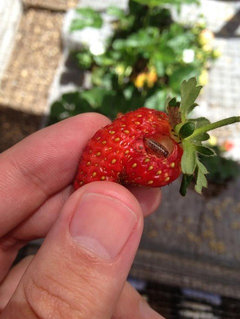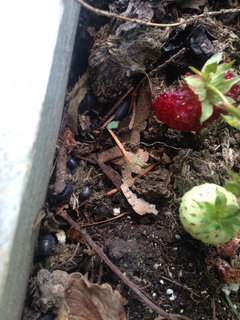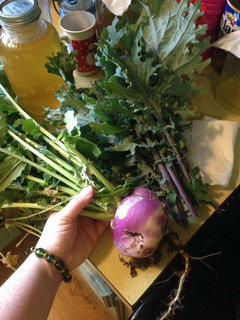help! pill bugs harming strawberries!
Pill Bugs/Roly Poly's are everywhere in our garden. And they are burrowing into our strawberries (burrowed into our beets last year). What can be done?
Comments (61)
Kimmsr
13 years agoThis link might help some people understand the place Pill Bugs have in nature.
Here is a link that might be useful: About Pill Bugs
dicot
13 years agoY'know what else helps people understand the place of pill bugs in nature? Observing pill bugs in nature for many years, not reading random web links about them in a biome that has nothing to do with my garden.
Related Professionals
Wrentham Landscape Architects & Landscape Designers · Lyons Landscape Architects & Landscape Designers · Salisbury Landscape Architects & Landscape Designers · McKinney Landscape Contractors · Milford Landscape Contractors · Ellicott City Landscape Contractors · Hayden Landscape Contractors · Hendersonville Landscape Contractors · Hilton Head Island Landscape Contractors · Kaneohe Landscape Contractors · North Lauderdale Landscape Contractors · Olympia Landscape Contractors · Boston Decks, Patios & Outdoor Enclosures · Leander Decks, Patios & Outdoor Enclosures · Lockport Decks, Patios & Outdoor Enclosuresrlv4
13 years agoMy thoughts exactly dicot! I am really surprised it has not been suggested yet that the OP go out and get a god reliable soil test!
gjcore
13 years agoMy garden has tens of thousands of pill bugs and I've never seen any damage that they have done. I also have quite a few strawberries.
Dan _Staley (5b Sunset 2B AHS 7)
13 years agoWow, that must be one reliable soil test.
Think of the postage to mail that off. ... = : o
Nonetheless, I can't say I've ever had pillbug problems myself, but I also use wood chips and mulch and such well away from the veggies, so they hang out there, and I think the commute is too long for them to justify the reward, so they just chill in their neighborhood.
Dan
californian
13 years agoDan, if you never had roly poly problems then why are you responding to this post twice like an expert on them? People in different part of the country have different pests. In southern California roly polys are one of the biggest garden pests, but then again we never heard of some of the bugs others might have in other parts of the country. And then kimmsr read something from someone in south Dakota that says roly polys are a beneficial creature (I don't want to say insect) and believes it, and the author even admits south Dakota only has four of the 20 types of these creatures. Just today I found some roly polys eating my strawberries, and these weren't damaged by anything else. Someone mentioned toads will eat Roly Polys, but we don't have toads around here, too dry, so maybe that is why these roly polys can multiply to such vast numbers that they become the one of the worst garden pests. We do have lizards, but they won't eat roly polys. I tried feeding them to a pet lizard my kids had and she wouldn't touch them. Seems like someone who knows nothing about these creatures wrote that they are beneficial and only eat decayed stuff, but never actually went out into a garden to see what they really do eat, which is just about anything they can reach and that is soft like seedlings, tomato and squash leaves, strawberries, tomatoes, fruit from trees that fell on the ground, decayed vegetation, even coffee grounds.
rlv4
13 years agoWow, that must be one reliable soil test.
Yeah, you have to be careful not to be fooled by the soil test form Satan. He will tell you to use Miracle Grow and Roundup! ;)
Dan _Staley (5b Sunset 2B AHS 7)
13 years agoDan, if you never had roly poly problems then why are you responding to this post twice like an expert on them?
Reread thread.
Thanks!
Dan
keppers79
Original Author13 years agoI'm in south/central US so I think they are more of a pest here. We do square foot gardening so everything is very close together and there is also mulching (plenty of places to hide out). We also can only get to the garden location once a week so we do miss some of the fruit which might be attracting them. I am sure they are doing the damage, though!!!
dicot
13 years agoSooooo....., Back to the question of what works for those of us who do experience (or think they are experiencing) damage from the woodlice. For all my complaints, I rarely kill them, so to work around them:
I) I germinate mainly in flats and rarely in situ, the flats are located outside on old coffee tables that I try to keep as bug/pathogen-free as possible.
2) I remove woody mulch from the transplant zone and sprinkle wood ash around the seedlings (which becomes ineffective quickly when watered).
3) If really annoyed, I spread some Tanglefoot gook on the stem right at the soil line with a toothpick (which can get VERY messy later on, but at least I still have the plant).
4) I overplant my seedlings, expecting to lose a few.
gjcore
13 years agoKeeping the berries off of the soil goes a long way. I think there's a reason they're called "straw"berries.
keppers79
Original Author13 years agoI like that idea, gjcore! I think we have some hay there (it's hard to find straw in this area). However, I can definitely add some more.
yogagardengirl
13 years agoI frequently find these critters happily burrowed into my strawberries. I'd agree they seem to go for the ripest ones. Anyway, I just brush them off, give the berries a good rinse.
I would like to try the straw to see if that helps. I don't know where to get it though.carolb_w_fl_coastal_9b
13 years agoWow! Bit of a controversy over this, it seems.
IIRC, pill & sow bugs do not possess the organs needed to digest fresh food - they eat food that is already decaying.
IMPE, they follow the ever-so-sneaky slugs & snails (& who's to say that sometimes they haven't 'burrowed' into a miniscule cut or puncture in the fruit's skin that we can't see w/ our naked eyes?)
Ummm - kinda limiting to claim that science is unneeded - don't think that'll get anyone very far...
Here is a link that might be useful: Pillbugs/Sowbugs @ UF
californian
13 years agoThose of you who keep harping that roly polys only eat decaying vegetation are completely 100% wrong. carol w fl, in the link you just posted where does it say they only eat decaying vegetation. In fact it says they will damage roots. These ivory tower writers should spend some time in a real strawberry patch and then they will make a remarkable discovery, they have been repeating the same false info endlessly. Just because they do eat decaying vegetation you all seem to take that to mean that's all they eat. Wrong conclusion!
hamiltongardener
13 years agoI keep seeing this come up every year and, like others here, have witnesses an infestation of roly-polies damage my plants and fruits.
So I've looked at a few studies:
http://www.cps-scp.ca/download/Chapter%202%20-%20Causes%20of%20Crop%20Loss.pdf
http://www.bio-nica.info/Biblioteca/Cole2004InsectsVegetables.pdf
http://digitalcommons.unl.edu/cgi/viewcontent.cgi?article=2129&context=extensionhist
These are the first couple of hits from universities I saw. They all say that pillbugs and sowbugs will primarily eat decaying matter, but also young plants and fruits, especially those which touch the ground.
A couple of years ago I had such a bad infestation that they were crawling UP the plants like tomatoes to get the fruits and tender new growth. There were thousands.
Perhaps the posters who believe they only eat decaying matter have not had a large population of pillbugs. If they can find enough decaying matter, they don't do much damage to plants, but if there are a lot, they go for whatever food they can get.
Incidentally, that was the first year I mulched my garden after reading all the advice to mulch, mulch, mulch. The next year I planted "conventionally" leaving bare soil around the plants and there were considerable less pillbugs, back to "normal" levels. I have wondered often if I provided a perfect living/breeding ground for the little buggers in all that mulch which caused the population explosion. Or maybe it was just a freakish bad year for them. I won't know unless I recreate those conditions in my garden, but I am scared to do it again. These things were EVERYWHERE!anney
13 years agoOkay, there's controversy that I don't have an opinion about either way, but if you want to get rid of the pillbugs, there is a way.
Use the new incarnation of Sluggo, which appears to be the same as the old incarnation, but it wears a label now. Monterey Sluggo Plus® Approved for Organic Gardening
If you like Sluggo®, youÂre going to love Sluggo Plus®! Controls snails and slugs, earwigs, sow bugs, pillbugs, and cutworms. Can be used on ornamentals, vegetables, fruit trees, berries, turf, and non-commercial greenhouses. ... Sluggo contains naturally occurring iron and phosphate and is safe to use around pets and wildlife.
I have an older version of it to finish up that contains iron phosphate but was not approved for the organic label, though actually it was organic.
Tgips
11 years agoI've read many of the posts on this site re: pill/sow bugs and took some of the advice and have been reducing them although probably not eliminating them from the strawberry patch. I put down saucers with beer and also small 6-inch squares of wood, pressing them onto the soil. IN the morning, I found a few sow bugs in the beer (no slugs) and many of them underneath the saucers and the pieces of wood. I scooped them up, dirt and all and put them in a pail which I then half filled with water, added a little organic pesticide, and rubbed a band of mineral oil around the inside of the pail to deter those who managed to crawl up the sides.
I realize that the first mistake I made was spreading compost from my compost pile in the strawberry patch without digging it in. It was loaded with earthworms AND also sow bugs.
PillbugBerrryeater
11 years agoAfter a few years attempting to figure out what was eating my strawberries and finding repeated insistence online that it was not pill bugs, I wanted to upload this picture I took today of a berry I picked a few minutes ago, with a little pill bug eating some lunch.
The wound it is leaving is consistent with all the wounds I have found in our strawberries, last year we lost about 2/3s of our berries due to this so at least I know now. We keep a separate patch for birds to eat, and this berry is from our patch completely covered in bird netting.
Felt compelled to sign up and post this as confirmation for the people seeding doubt about the possibility pill bugs could be a culprit in their gardens.

zeuspaul
11 years agoFor the believers. Do collars work to keep the pill bugs from eating my squash sprouts? I recently got 15 cyds of mushroom compost. I mulched the squash hills and am now inundated with pill bugs. They eat the leaves as they just start to appear. Once the leaves spread open and are above soil level they seem to be ok.
I cut some 2 inch and some 4 inch pvc pipe about an inch long. I placed the collars around some sprouts that are just beginning to emerge. Will it work? Can these little devils climb pvc? Any other ideas?
Thanks
Zeuspaul
cosmicent
10 years agoMany Scientists here but few answers to the question! I think zeuspaul's pic in this forum says it all. his pic depicts EXACTLY whats happening to my strawberries... i need to know a good organic pesticide besides diatomaceous earth (its still rainy here).
ernie85017, zn 9, phx
10 years agoSluggo Plus. I use it periodically in the strawberry beds when I see damage. I guess it wears off, and they come back, so I apply again. You only use a little bit. Safe for pets, etc.
But I wonder about the earthworms.
I have strawberry damage like the photo. Just when they get ripe enough, I pick one and it has holes on the underside.Ack!
chickencoupe
10 years agoI'm with ernie. Sluggo Plus
The drought has brought on a scourge of pill bugs in my yard and garden.
It is because there is not sufficient organic materials for them to eat. So they start in on the plants. What would you do if you were a pill bug without organic material to eat? A soft juicy fruit would suffice. As the drought eased and my work composting carries on it is getting better.
Without a doubt, I had to use Sluggo Plus. I worry about the earthworms, but I had no choice. It is either the pill bugs or my plants. I only use it in areas absolutely essential.
I like pill bugs. They are wonderful composters, they mine the soil for toxins and remove toxic metals, they break down the slow decomposers like wood chips. They're great unless you have them in the trillions without sufficient food.
Bonniewasmax
9 years agoPILLBUGBERRYEATER, Great photo !!!
Well, to stay 100% safe and organic I will try the same idea's posted for slugs, like, orange rinds and beer. I will also leave out some broken pottery and just relocate the pill bugs elsewhere.
The Iron Phosphate products have EDTA and are tempting to animals because of the wheat gluten. The EDTA is a chelate and works together with the iron phospate. If ingested by dogs the levels of iron become toxic if enough is ingested. Dogs don't have the same ability as humans to remove excess iron from their systems. Plus, if you are using a product that kills earthworms it can't truly be organic and safe.janciecookie
8 years agoPill bugs, roly polies, whatever you want to call them, do eat bedding plants. I see it with my own eyes. It is a constant battle here in my Mississippi flower beds. They do eat the roots and leaves and will kill the plant. I battle them constantly. Takes some of the joy out of gardening :(
floral_uk z.8/9 SW UK
8 years agoThe creature in the strawberry doesn't look like the Pillbugs we get here. It appears to have a clearly defined head. Is that what they look like in N America?
kimmq
8 years agoWhat is in that picture, posted 2 years ago, is not a Pill Bug, Sow Bug, Potato Bug, or Wood Louse, which may help explain some of peoples attitudes, they do not know what those arthropods look like.
Many people that have posted things similar to what janciecookie has above have not read what those of us that said the Pill Bugs PRIMARY food source is decaying vegetation. I have not seen much that would lead me to the erroneous conclusion that Pill Bugs will not eat strawberries or seedlings and I find many people that misinterpret what we say about that as well.
Most likely the primary problem many people have with things that eat their plants is slugs, cutworms, or many others with the Pill Bugs coming along when they are there to clean up, and the arthropods get the blame.
kimmq is kimmsr
maxjohnson
8 years agolast modified: 8 years agoI transplanted some small tomato seedlings and the pill bugs gnawed the stem overnight.
I also transplanted some young strawberries in a container with fresh potting mix that made myself, no bugs in it. And in the next 2-3 days something gnawed all the leaves, even went I protected the plan from above with a mesh dome so it was fully protected above the soil surface. I dug underneath the root to find two millipedes which must have came with the strawberries plants, and people say they only eat decaying matters.
I am sprinkling diatomaceous earth and using organza bags to protect my strawberries now.
Orite Levy
8 years agoFunny how this thread keeps going on and on. These little guys are an issue where I live in northern Cali. Especially now that we have a drought. There are thousands! I literally picked one of these little pill bugs up the other day and it exploded hundreds of translucent babies all over my hand. It was crazy. This year I decided that before I put my garden in I would put all my ducks into the garden area to clear it of all insects, well it worked pretty well. Next I decided to steal a hatching duckling and imprint him on me so I could have a garden buddy and now I have Francis the garden duck. I let him out of the pen everyday with me into the garden and he goes around and eats all the little suckers he can find. Snails, slugs, Rollie's etc.. Every now and again he eats a leaf of something good but I can share, we can call it payment for a job well done. I never leave him in the garden overnight, maybe I should if that's when these bugs are working but so far so good. I will say though that I still have strawberries that are attacked but it is much less than before and they are always the ones laying directly on the ground so I go through and lift most of my strawberries up off of the dirt. I don't dare mulch my berries, not gonna give them a place to hide and be lazy.
Side note, don't put chickens or ducks in your garden in any numbers as they will destroy much of it. One at a time and monitored!! They also can not be trusted. Francis is still only two months old and learning my ways not my other ducks ravaging ways.
chickencoupe
8 years agoYeah. I don't think this thread will ever die. lol
This year? We've been beneath the torrential rains. Pill bugs (and everything) on the veggie plants escaping the water --even the hugel bed must have been flooded below from the record rainfall. Pill bugs had a good ol' time eating the lower leaves of my tomato plants. It was clear as day. With a little experience behind me, I didn't fret over it. The plants were mature and I know that the other leaves will continue to soak up the sun. I wanted to see what would happen, so I let them be. When the rains stopped, I tied up the plants and got them off the ground. A few remained, but most went back down into the hugel bed. After the stress was removed, my plants probably emitted its own defense. They all area holy on the bottom leaves, but fine.
They attack weak plants if they haven't sufficient food or the right kind of food. We have them in large numbers. They are now just a part of the gardening process. i hold the spinosad at the ready if they should threaten to destroy any veggie plants (usually at seedling stage).caseybaze
8 years agoPill bugs have been eating my strawberries. They eat them as soon as they are all red. I would like to leave em on for another day cause i think they taste better. There is no damage to the berries and they still eat them. Kimmsr your an idiot.
kimmq
8 years agocaseybaze, bad English here, "Kimmsr your an idiot." More properly it would be "Kimmsr, you are an idiot" or "Kimmsr, you're an idiot".
kimmq is kimmsr
Farmer Chris
8 years agoThey've been in my garden this year as well. I planted squash seedlings and they ate all the softer plant tissue from the stem, which left only the veins! I wish I would have taken a picture. I've been trapping them with a tuna can and beer. See here: http://floravistafarms.com/2015/07/30/245/
wrccrain
7 years agoThey hammer my strawberries, especially since I mulched the plants. Looks like I'll have to remove the mulch, get some sluggo, add some straw and give up some of my beer as well. I live is southern Oregon and we get plenty of rain and every new thing I plant comes with a new pest and a half dozen new weeds, So much for trying to do weed control on strawberries with mulch. I have about 150 strawberry plants and a few thousand pillbugs for now. Time to start eliminating...
wayne_5 zone 6a Central Indiana
7 years agoI saw my resident toad in my strawberries again yesterday...good boy. I used to have tiny black bugs eating on the very best red ripe berries. I am not seeing that nowadays.
Jennifer Londo
7 years agoI use neem oil and apply it every few weeks. It does a good job at keeping the bugs away from the garden.
kimmq
7 years agoThe idea of "keeping the bugs away from the garden" is not necessarily a good one since many "bugs" are beneficial. The idea, for an organic grower is to properly identify the insect causing the harm and control them, and the problem may not be that Pill Bug, Sow Bug, Wood Lice, etc. who may be cleaning up after a slug or a vole.
Try to understand the role various insects play in the garden.
kimmq is kimmsr
artinnature
7 years agolast modified: 7 years agoI'll add my experiences to this substantial list. I garden 15 miles north of Seattle and have been since 2006. I'm all organic and very much a "chop and drop" gardener - so a lot of fresh woody and green organic matter is laying around at all times. My three compost bins are nearly always filled to capacity, and I don't have surplus yard material hauled away, so this is how I deal with excess organic material. I would say that the woodlice have become steadily worse over the 10 year period. I think that all of the organic matter is one contributing factor, but I wonder if something else is going on in the environment that favors these critters, because I'm clearly not the only one struggling with woodlice. It would be interesting to get some perspective from old time gardeners with a lot more experience than I have regarding these critters: have woodlice always been a problem, or is this situation new or different?
The worst damage is on seedlings: beans, peas and pepper seedlings were heavily damaged this season. I had to replant several rows of early peas and later had to replant pole beans. Nearly every seedling was killed in some rows. They cluster around the seedling stem right at and slightly below the soil level as they feed, and shelter in the cylinder shaped crevice, eventually girdling the stems. Once the plants are over 8" high or so they don't seem to be bothered. Strawberries are probably the next most affected crop. I find this damage somewhat less heartbreaking than the seedlings because no plants are actually killed--and I don't have to replant anything--its the fruit that is eaten. Yes, they ignore the berries until just before its perfectly ripe, exactly one day before optimum ripeness to be precise.
My three compost bins are always teeming with hundreds of thousands of woodlice. I have no way to stir my compost, so its rarely hot and apparently an ideal environment for them. Occasionally the critters crawl up the sides and gather under the lid, perhaps when it does temporarily get too warm for them in the compost. Of course the compost eventually makes its way into the garden beds, along with millions (not hyperbole) of woodlice and their larvae.
My veggies are all in raised beds, 24 are wood, one is galvanized steel. I go out after dark almost every night to see whats going on in the garden (slugs, snails, root weevils, raccoons, etc.) and numerous woodlice are always hanging out all over the wooden raised beds, presumably after or before having some fresh garden salad, to round out their diet. I will probably gradually convert all of them to steel. In addition to bean seedlings and strawberries, woodlice apparently eat wood, and they love to shelter in the crevice between the wood and the soil, so any reduction in the amount of wood in the garden will hopefully help. I've been mulching pathways with arborist much--because its free--and I think that will have to be discontinued as well, and I'll have to gradually convert to gravel pathways.
Regarding natural predators, we have pretty much - none. There are no frogs or toads at all in my neighborhood. We have a lot of water and many streams (I have one on my property) but I suspect the water is too polluted for amphibians...who knows. There are some songbirds--towhees and such--but I never see them digging in my raised beds, which is what they would have to do to gain access to woodlice during the daylight hours.
I've come to the conclusion that chickens may be my best weapon...I'm assuming they enjoy eating woodlice, yes-no? I know that chickens need to be kept in their run most of the time or they will destroy a garden. My plan is to let them out from time to time, supervised by me, and herded to where I know there are abundant woodlice. I would then expose the nocturnal and hiding woodlice so the hens can do their worst. A team effort is required, I think. I can imagine for example, having the flock ready and waiting when I move compost--and millions of woodlice therein--from the bins to the garden beds. Perhaps even turning a liability--inedible and destructive crustaceans--into an asset - fresh, edible eggs. One can dream.
But -- as much of a problem woodlice have become in my garden, they positively pale in comparison to the rats.
Cheers from Cascadia
User
7 years agoWe've recently moved to a new home with about ½ an acre of garden space. The last two seasons have been spent importing organic material to improve the soil. Wood chips, rotten straw/hay, leaves, manure and whatever else we can find. The pillbugs have multiplied to apocalyptic numbers! Anywhere in the garden you can pull back a bit of mulch and find piles of them. Our chickens and ducks spend hours picking away at them each day but haven't made a dent. As mentioned above, they do love strawberries and are capable of tunneling into any fruit they desire. This last year I mulched heavily with rotting hay around most of our root crops...big mistake. Sweet potatoes, potatoes, radishes, carrots and beets all were devoured. However, the same crops in adjacent rows with no mulch weren't touched.
My plan is to continue to import organic matter and change nothing else in my system to see if things balance out and more pillbugs predators take up residence.
Insanity: doing the same thing over and over again and expecting different results. ~Albert Einstein
lynnstarrs73
6 years agoPlant strawberries in a raised bed and you are half way there. Pick through with a spoon, looking in their favorite moist cracks. Catapult the ones you find to areas with mature plants. Sprinkle coffee grounds in their favorite spots. Enjoy your strawberries--they definitely eat them if you don't control them. Keep the surface of the soil dry as much as possible--they really need moisture.
carolrcl
6 years agoSeeing as there was activity on this 7 year old thread just a few months ago, I had to add my experiences: I grew up loving pull bugs and appreciating their benefits to the souls and garden--until last year when they ravaged my strawberries. I was very skeptical that it could be them--they don't eat fresh fruit! But over time it became undeniable. Even if it was a slug or other critter that made the initial hole, the pill bugs cleaned out the insides. I found berry after berry that was almost completely hollow with multiple pill bugs inside going to town. There was just a pill bug sized hole and a hollow berry. There were also berries that were eaten in half, like in the picture.

This is year I raised all the developing berries that I could find off of the soil--hanging them over the side of the planter or propping them up over leaves. It we were able to keep control of them in the strawberry patch that way.
But the worst invasion was my turnips. They burrowed into the roots and nearly hollowed them out. The first one I pulled out was bigger than my fist and I noticed a hole in it near the soil line.
The hole had been there for a long time as the "skin" had grown over the exposed flesh down into the hole. But when I washed it, pillbugs started coming out. When oncutnit in half, I found the entire thing riddled with tunnels and cavities, and contained more than 50 pill bugs of every size dig into the flesh, clearly eating, plus a couple of earwigs and tiny slugs. The photo is after I washed them all down the garbage disposal, though I did find more holed up in other cavities as I cut it up

You cannot convince me that the pill bugs in that case were only "secondary" pests. Even if they didn't start the initial hole, they were clearly the ones colonizing and breeding in it. I later discovered similar holes in every one of the turnips in my small patch. I found this thread because I was looking. For advice as I get ready to plant a fall crop of root vegetables and do not want a repeat of last year's devastation. I will be trying the citrus peel method. Will other fruit castings work for this as well? We don't always have citrus on hand this time of year.
rgreen48
6 years agolast modified: 6 years agoI don't really think anyone was saying that pill bugs won't eat fresh plants and fruits, I think the point is that they prefer decaying organic matter.
Take your example of strawberries... you found small slugs at the damage sites. Slugs will definitely eat fresh fruit and plants. Leave a cut strawberry out for a short time. It begins to rot almost immediately. Tomatoes are the very same way. Pill/sow bugs love that decaying fruit.
In most cases it's a matter of convenience. The pill bugs come along, see/smell/sense a wound in a plant, and they begin to take advantage of the food source.
There are times when populations can get out of control. On the vegetable forum yesterday, someone explained that they had used a leaf mold as a mulch. The pill bugs were no doubt in the leaves and were transferred in large numbers, along with unhatched eggs. Had the leaf mold not been moved, the pill bugs would have continued to expand their population in relation to the amount of decaying leaves in the pile. When moved to the garden bed, now you have adults wandering around for food, and eggs hatching with nothing to eat but emerging seedlings. It was an ecosystem out of balance.
I don't have any solutions other than to change the conditions or use a 'bait' type of control that fits your gardening philosophy. Oh... and just to hope you get to enjoy at least a good portion of your hard work!
Let us know if the method you are going to try works well on a consistent basis. :-)albert_135 39.17°N 119.76°W 4695ft.
6 years agolast modified: 6 years agoSomeone must have written a good article for the hobbyist and amateurs.
This paragraph seem to be a fair summary, ...Woodlouse - Wikipedia - "...generally considered beneficial in gardens for their role in controlling pests, producing compost and overturning the soil, they have also been known to feed on cultivated plants, such as ripening strawberries and tender seedlings.''
Here and elsewhere strawberries are mentioned. We have had problems with bean seedling and pill bugs or sow bugs or whatever [This Wikipedia link has 19 ''common names'']. We have tried banana peels and these seem to only serve as breeding grounds. We could not relate the distraction to any decrease in damage to the beans and might even have increased the number of hungry adults.
artinnature
6 years agolast modified: 6 years agoI posted above in October 2016 -- and as is always the case in gardening -- this season is filled with new, um...learning opportunities?
Overall the woodlice damage has been much reduced and I think I know why, which means I must be learning something;-)
I did not put any of my woodlouse infested compost in the raised beds this year due to some health problems, I just top-dressed as needed with commercial soil amendments. I also built a multi-tiered strawberry pyramid. Finally--because we got a new puppy and had to reduce mud and dirt being tracked into the house--I mulched all of the pathways between the raise beds with pea-gravel rather than arborist tree-mulch. I didn't have any problems at all with bean and peas seedlings being destroyed by woodlice and very little damage on the strawberries -- and I can only deduce that these changes--some totally incidental--have helped immensely.
The one and only woodlice disaster was the first round of cucumbers, and I think I know what went wrong there too. There was a large and low to the ground thyme bush right next to the cucumber trellis and I think the little blighters would hide under the thyme by day and come out at night to do their worst on the cuke seedlings. Over the course of five or six nights all twelve seedlings were destroyed. By the time they were all dead I finally caught on to what had happened, transplanted the thyme to other places where I'm not planting vegetable seeds, and replanted the cukes in the same spot. They all grew with no problems whatsoever and as I type these words my wife is in the process of canning seven jars of dill pickles!
However!---something almost as bad has taken the place of the woodlice--tiny centipedes less than 1/2 inch long and very, very thin!!! I've seen these in past years as well but their population seems to have exploded this year as the woodlice have subsided somewhat. they have mostly damaged the ripe strawberries but I've also seen them infesting potatoes. If I go out at night with a headlamp the wooden raised beds are covered with the tiny creatures and I could literally spend three hours squashing them if I were able...they aren't very fast.
So, what have I learned?
1) Don't put woodlouse infested compost in your garden where you will be planting susceptible seeds.
2) Mulch pathways with gravel rather than tree-mulch or wood chips.
3) Raise strawberries up, up, up as much as possible to keep them out of reach.
4) And finally --this one blew my mind-- Don't plant seeds near any bushy or perennial plant that has a lot of foliage near the ground. Woodlice love the sheltering shade and moisture provided by low bushy plants and will happily launch their nightly raids and then disappear back under the foliage by day. In the future I will only plant seeds in beds that contain nothing at all, no overwintering veggies, no perennial herbs, nothing --- just bare soil.
Cheers from Cascadia
e alexander
4 years agothe woodlice infestation I have is out of control. the soil in pots are half woodlice even after wintering over and every pot underneath alsohas hundreds of them. The property I'm on was allowed to have overgrowth so every bit of dead branches and trees became woodlice condos and then they start eating the healthy tissue of trees. Every single plant in the garden that is more of a soft tissue plant as opposed to a dryer tissue one they eat the roots of immediately. Every vegetable I plant in my organic vegetable garden I dig one soil shovel and there's hundreds of them. I brought in compost that was perfect but unfortunately someone who is helping me put it on bare ground instead of my raised bed before it got put in there so of course they moved right in. I've never seen so many of these things and they are voracious. People that think they're just no big deal and just eat decaying vegetable matter have no idea of what happens like any predator they eat what is available and in large numbers they will eat everything that's available including the mortar in your walls I've seen them eat and excrete and it's absolutely mind-boggling the damage these things can do. As long as there is dampness they are on board for just about anything. I'm a biologist I've studied entomology even though these are not an insect but actually a crustacean I can tell you in an explosive population they will take you down. DE is the only thing I have had any success with and just keeping things as dry as possible and removing all growth from any foundations made of brick. absolutely amazing to me what these creatures can
Eric Matthews
3 years agoCentipedes will eat pillbugs.
And here's the spider you want in large numbers: https://en.wikipedia.org/wiki/Woodlouse_spider
https://spideridentifications.com/woodlouse-spider.html
I would experiment giving those spiders shelters that don't get flooded easily while watering.
If you have an undisturbed corner of the garden where you purposely harbor woodlice, then you may attract their predators as well, from which you can transplant those predators to parts of the garden where you want them.

















rlv4